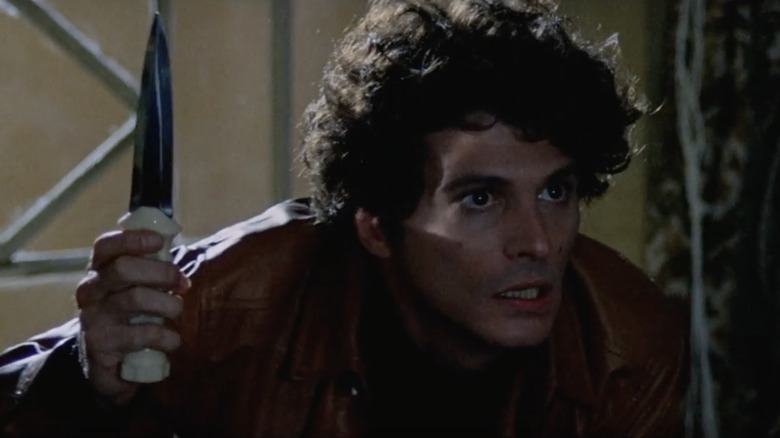The Western That Inspired One Of Horror's Greatest Directors
When you think of the giallo subgenre of horror, chances are pretty strong the first or second name that enters your head is Dario Argento. Through his films "Deep Red," "Opera," "The Bird with the Crystal Plumage," and of course "Suspiria," the Italian director created horror pictures filled with vivid colors, a healthy dose of impressionism, and stylish violence that have stood the test of time. While one would assume Argento was a disciple of some horror legend, as so many horror junkies worship today, the truth is he was not really working in that world prior to making his directorial debut with "The Bird with the Crystal Plumage." Instead, one of his key inspirations and mentors was nowhere close to the genre but a master of another, the Western.
Dario Argento began his career in moviemaking as a writer, and most of the time, he was writing Spaghetti Westerns. His credits included movies like "Today We Kill! ... Tomorrow We Die!" and "Cemetery Without Crosses." But his big break came from working on the screenplay for maybe the genre's greatest entry from its greatest director. That would be "Once Upon a Time in the West" from the legendary Sergio Leone. Working with Leone had a tremendous impact on how Argento perceived and approached filmmaking, and without working on this picture with cowboy hats and dusters, who knows if we ever would have gotten a bonafide classic about the scariest dance school in Germany.
'I was a small voice, but he heard me'
Before becoming a screenwriter or a director, Dario Argento worked as a film critic. Most of the Italian critics at the time were not terribly into the work of Sergio Leone. In a piece for The Guardian, Argento said:
"I first heard of Sergio Leone when I saw 'A Fistful of Dollars.' I saw that it was a great film, but for other critics it was nothing. They don't understand Sergio in Italy; they didn't like him. They started to understand him much later, with his last film – but that was too late."
Today, it seems insane that people did not enjoy the first of Leone's Man with No Name Trilogy with Clint Eastwood, but Argento, being one of the few and proud defenders of his work with his reviews in the now-defunct left-wing newspaper Paesa Sera, put him Leone's good graces. The two took up a correspondence, and one day, Leone asked Argento to write a film for him, even though he had not written a screenplay before. Argento set up shop with a young up-and-comer named Bernardo Bertolucci to hash out a script.
"We began with nothing except an idea of Sergio's: he wanted to have a woman as lead for the first time. I would write on my own, then Bernardo would write on his own, then we would write together. Once a week Sergio would come to see how we were getting on and offer his thoughts. He was incredible at generating ideas. He made me realize the director should always be involved in some way with the screenwriting."
This is quite a way to be thrown into the fire, working for a titan of Italian cinema and alongside a person who would become one. That amount of talent piled in a room together obviously had everyone working at the top of their games. "Once Upon a Time in the West" is a Western epic of the highest order, regardless of its country of origin. It is a story of revenge, property rights, and power, wrapped up with all of Leone's signature trademarks for maximizing tension in every single moment. It's a monumental picture, and even Argento could not deny its impact after seeing it with an audience, saying:
"Sergio had achieved greatness. This film was impossible to better: after this, the western was finished. It's such a nostalgic film, a very sad film. I love how slow it is. How enormous. It will be here forever."
A collaboration leads to a new path
After collaborating with Serio Leone and Bernardo Bertolucci on "Once Upon a Time in the West," Dario Argento now found himself in the movie business. He was actually the one helping create stories on screen, not just writing commentary about them. Just a couple of years later, he would make his directorial debut. He recalled:
"I continued to write for films, and a couple of years later I wrote 'The Bird With the Crystal Plumage.' I hadn't planned to direct it, but then I thought, 'Well, maybe I could.' I remember meeting Bernardo at his house. He had just finished writing 'The Conformist.' I had my script with me; he read mine and I read his; we both liked each other's and wished each other luck."
Turns out their luck would prove valuable, as Argento's "The Bird with the Crystal Plumage" became a genre-defining film for giallo, and "The Conformist" turned out to be Bernardo Bertolucci's masterpiece, as well as a real eye opener for me when I was a college freshman taking an Italian cinema class. Both films could not be further from Sergio Leone's Western world, but you certainly can see the DNA of how Leone builds tension in these two works. The climax of "The Bird with the Crystal Plumage" is filled with a lot of Leone-esque extreme close-ups, especially one particular shot of star Tony Musante's eyes. After the release of "The Bird with the Crystal Plumage," the rest is history. Dario Argento rose to become one of horror's most celebrated filmmakers, and this experience showcases the importance of really listening and learning from those who came before you to make your own art that much better.


